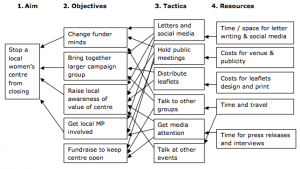
7 Steps to Planning an Effective Campaign
- What does it mean: First define your core aim and purpose. This is the outcome that the campaign hopes to achieve
- Breaking down the Aim to Objectives: These are smaller more achievable goals that build towards fulfilling your aim. E.g. attracting media attention or raising awareness
- Tactics and activities: This is whatever you need to achieve goals and aim e.g. writing and distributing leaflets, setting up an email or twitter account, organising a public meeting
- Resources: Do you have the resources you need to campaign effectively? For example, how many people are involved? How much money do you have? What skills do you have? Do you have access to meeting space? Or connections to decision makers?
- Next steps: Organise a campaign team, research your issue, identify key allies
- Influence: Identify key decision makers you want to influence and work out ways to contact them. It could help to ask women involved in the campaign who they know and identify influential figures through this. For example, a famous patron can help with access to decision makers or with influencing wider groups through media or other dissemination.
- Timescale: Decide the timescale and act on this.
See this useful flow cart below for tips on how to plan:

Case Study: Crossroads Women’s Centre
http://www.crossroadswomen.net/Crossroads%20Women%20History%20of%20Centre.htm
The Crossroads Women’s Centre began as a squat in Drummond Street near Euston station in 1975, opened by the Wages for Housework Campaign. The charity, Women in Dialogue (WinD), was created in 1976 to run the Centre. In 1978 the area was redeveloped and CWC were evicted.
CWC gained support from other squatters including Bengali families they had worked with to get housing and protection from racist attacks, from community groups, and from local business people.
A determined contingent of women of different races, ages and backgrounds walked into Camden Town Hall to claim a new space. One chained herself to the first floor balcony and dramatically unfolded yards and yards of a petition with thousands of signatures demanding a women’s centre. After a year in limbo, Ken Livingstone, then Camden’s Chair of Housing, agreed to give the Centre a small rundown empty shop at a token rent. It became the King’s Cross Women’s Centre, and was home for 17 years.
In 1995 this area too was redeveloped. KCWC couldn’t pay the expected commercial rent, and were evicted. But unlike centres which closed down when funding stopped, KCWC were saved by the dedication and commitment of volunteers and supporters, spending over a year at a youth centre and a church hall.
The Centre’s expanding activities led to serious overcrowding. So buying a bigger centre became a long-term goal. In 2009, thanks to the generosity and commitment of volunteers, core users and supporters, KCWC were able to buy 25 Wolsey Mews.
The name Crossroads was kept, chosen to remind women of the old centre, and to remember the brave women of the squatter town of Crossroads, South Africa, who refused to be moved, keeping alive the struggle against apartheid.
Building a collaborative campaign
Partnership has sometimes been defined as “the suppression of mutual loathing in the pursuit of public funding.” And yet, we continue to work in partnership because we recognise the greater benefits. Benefits in collaborative campaigning can be:
- Greater clout in getting a message across through the contacts and networks of each organisation
- Convincing the wider audience of the message in that it is a shared view and not influenced by the priorities and needs of a particular organisation
- Helps the success of the campaign through sharing of resources and workloads
- Helps tackle competition
- Drives down the overall costs of the campaign/s
- Creates a high profile partnership that provides other opportunities for collaboration
- Produces the potential for revenue generation opportunities
- Builds the internal capacity of the individual partners to sustain the solution
But there are also challenges in collaborative campaigning. Knowhow Nonprofit collaborative campaigns site lists some of these and gives further useful guidance on mutual campaigns. http://knowhownonprofit.org/organisation/collaboration/working-collaboratively/campaigning-in-collaboration-ncvo
Challenges could be:
- Reaching agreements which can take time and delay action
- Mistrust as to the intentions of partners
- Partners who are overly protective of their own field or contacts
- Disproportionate contribution of resources
- Lack of clarity about roles and responsibilities
- Communication problems
- Compromised messages
- Uneven profile or publicity
- Reputational risk through association
- Transaction costs
To help develop successful collaborative campaigns here are some tips:
Agree values of the partnership
Partners usually feel these are implicit e.g. we all agree that we want equality for women. However, how individual organisations go about this can be different – some might believe that any contribution from private businesses is helpful, others may not want to be associated with a particular business. Disagreement on fundamental ethos or values can cause destructive conflict, often not implicitly stated.
Agree a very clear, overarching goal
Make sure this is in simple, clear language and all partners want this.
Agree the rules
This means having a clear and practical Terms of Reference (TOR) which lists the fundamental purpose and objectives, and what is or is not permitted in terms of procedures e.g. can a press release be issued without agreement from all partners. All partners need to sign up to these Terms of Reference. The TOR should also include a clear informal and formal approach to resolving conflicts. TORs are usefully developed if partners contribute experience of serious difficulties they have had in previous partnerships and solutions to these are included in the TOR.
Agree to disagree without condemnation of individual people or organisations
Disagreement can be creative – helping individual partners to build a better campaign. Make sure there are clear rules about disagreements e.g. ensuring that this is about an issue, not a person or an organisation or rules to allow the minority to publicly record their views and then review future response.
Define roles and responsibilities and play to your strengths
Do a skills and experience audit before deciding roles and responsibilities. Then the collaborative campaign can benefit from individual strengths and overcome lack of experience that some may have in certain areas. The collaborative campaign could provide a creative learning experience.
Make sure that the role and authority of the lead organisation is clearly defined as well as collective responsibilities. This must be practical. There are situations when individuals have to speak on behalf of the partnership – e.g. if funders want a quick response or the media asks for an immediate interview. The TOR can define when decisions have to be made quickly and how they are reported to and ratified by the wider group. It can also make clear where individuals cannot take on a particular representative role e.g. speaking for another organisation on a specialist matter. Make sure there is buy-in from the CEO and trustees of all the partner organisations, and the individual representatives on the partnership can reach them for crucial decision making.
Agree key campaign messages in simple language
Getting public interest means that messages have to be visually attractive and simply expressed. There are other ways of linking these messages to more complex evidence and research. Make sure that messages are always about the cause and not about partner profiles.
Prepare well, and be open to finding new ways of doing things
Make sure that every part of the campaign is prepared well, meetings are scheduled at the right times for key decision making. Individual organisations have different ways of working and as long as fundamental values are not in conflict, this could be an opportunity to find new ways or help reflect on organisational practice
Give partner status with care
Don’t include anyone as a partner who doesn’t bring something specific to that relationship or really needs the status of partner.
See these useful links for building campaigns:
http://www.unitetheunion.org/campaigning/campaigning-to-win/
http://knowhownonprofit.org/how-to/how-to-run-effective-campaigns
Case Study: Personal experience managing the Fair Deal for Women campaign
Challenges
- Political sensitivity : Timing and political sensitivity proves a difficult issue with an ongoing partnership campaign, especially when one organisation might want to be critical of the government, but partners might be in negotiations with the government on an issue specific to their organisation for example. This means that partners might want you to halt communications that could potentially ‘rock the boat’ with the government.
- Communication: Communication is key to the issue of political sensitivity. The organisations you are partnering with will be very busy, often running their own campaigns too so it is not always practical for them to update you on their negotiations with government- it’s up to you to be pro active and ask, and check their websites.
- Partners sometimes disagreeing on issues: A strong partnership will have diverse voices and therefore probably often differing opinions. It is important in a partnership that everyone feels listened to, and disagreements are balanced out. you can try to combat this with regular meetings, effective partnership communications and insight into their individual work.
- Capacity: Managing a partnership requires a specific member of staff to be dedicated to managing this relationship in many cases.
Key lessons
- Campaigns are successful during times of huge public debate, e.g. a general election so try to capitalise on these debates.
- Accessible language, animations and infographics successful in engaging the public in debate e.g. not using academic language and sector acronyms all the time.
- Constant communications is needed to keep debate going, especially on social media – this is in itself a full-time job.
- Collaboration works very well to build up your expertise – sharing resources is highly valuable.
- Collaboration also means your campaign can become attractive place for journalists and activists to come to for information and comment.
- More of a following is needed before you can hold events, and attract more high profile names, as well as influence politicians – but this will happen over time.
Share on FacebookShare on Twitter
